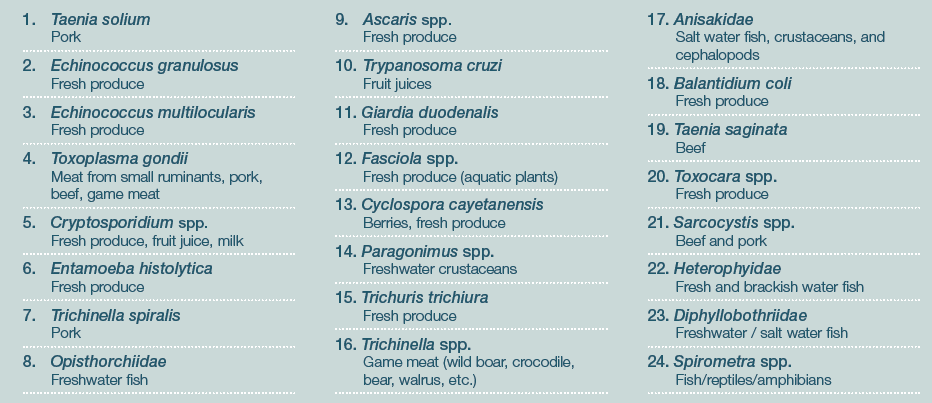The top ten ranking is a general, global perspective and does not necessarily reflect parasite rankings at a national level, said the report from the Food and Agriculture Organization (FAO) and the World Health Organization (WHO).
Rankings are based on the parasites' burden on human health and includes information on where they can be found.
Findings will be discussed during the next session of the Codex Committee on Food Hygiene in Lima, Peru from November 17-21.
Twenty-two nations and one regional body contributed, followed by an assessment and analysis by 21 experts on the impact of foodborne parasites. An initial list of 93 parasites was developed and then narrowed down to the 24 most damaging.
The criteria were number of global illnesses; global distribution; disease severity, mortality; increasing illness potential; trade relevance; and socio-economic impact.
First global list
Marisa Caipo, food safety officer in the food safety and quality unit (AGND), said it was the first time a list of global foodborne parasites had been put together, though there had been general lists before.
“We had a global approach so there were experts from different region and from all those places not enough information exists as there are no mandatory notifications in some countries," she told FoodQualityNews.com.
“If you eat and get sick from parasites the doctor does not have to notify anyone and the data can stay in the hospital or not be notified. Some parasites do not show symptoms immediately and it can be years after.
“[The aim is] to create awareness among the public and the other things that can be done to take a closer look at parasites. It is responding to the needs of different countries.
“Parasites are considered neglected diseases that are only found where there is poverty and poor sanitation in developing countries that has changed now in food safety with globalisation of trade, people moving all over the world and climate change. It is a problem we can’t neglect and must pay attention to and address.”
Parasites affect the health of millions every year, infecting muscle tissues and organs, causing epilepsy, anaphylactic shock, amoebic dysentery and other problems.
Notifications not compulsory
Notification to public health authorities is not compulsory for most parasitic diseases, and official reports do not reflect the true prevalence or incidence of disease occurrences (under-reporting).
The disease can have prolonged incubation periods (up to several years), be sub-clinical or asymptomatic, and epidemiological studies associating illness with a specific food type may not be possible.
Transmission routes for foodborne parasites can be by ingesting fresh or processed foods that have been contaminated via the environment, by animals or people.

The FAO-WHO report lists a number of ways to reduce the risk of parasite infections.
It was developed following a request by the global food standards body, the Codex Alimentarius Commission (Codex), for FAO and WHO to review the status of knowledge on parasites in food and their public health and trade impacts.
For farmers, it advises the use of organic fertilizer, particularly on produce, should be closely monitored to ensure it is composted properly and all fecal matter is removed. Water quality must also be closely monitored.
For consumers, it advises that all meat should be well cooked and only clean water should be used to wash and prepare vegetables.
Top 10 list
The top ten are Taenia solium (pork tapeworm) in pork, Echinococcus granulosus (hydatid worm or dog tapeworm in fresh produce), Echinococcus multilocularis (tapeworm in fresh produce) and Toxoplasma gondii (protozoa) in meat from ruminants, pork, beef, game meat.
Others include Cryptosporidium spp. (protozoa) in fresh produce, fruit juice, milk, Entamoeba histolytica (protozoa) in fresh produce, Trichinella spiralis (pork worm) in pork, Opisthorchiidae (family of flatworms) in freshwater fish, Ascaris spp. (small intestinal roundworms) in fresh produce and Trypanosoma cruzi (protozoa) in fruit juices
In Europe, more than 2,500 people are affected by foodborne parasitic infections each year. In 2011 there were 268 cases of trichinellosis and 781 cases of echinococcosis recorded.
In Asia, there is no precise national data but parasitic diseases are known to be widely spread and are recognized as major public health problems in many countries.
In most African nations there is no data at all on the prevalence because there of a general lack of surveillance systems.
In the US, Neurocysticercosis, caused by Taenia solium, is the single most common infectious cause of seizures in some areas where 2,000 people are diagnosed with neurocysticercosisevery year.
Toxoplasmosis is a leading cause of foodborne illness and death.
